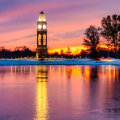Corydon was the first official capital of Indiana, established in 1813. The state constitution was drafted in this charming city in 1816, under a large elm tree known to this day as the “Constitution Elm”. However, it was decided to move the state capital to a more central location in 1825, and Indianapolis was chosen for its strategic location in the heart of the state. The whole process took more than a month, since Indianapolis was, at the time, an 11-day trip from Corydon. Indigenous peoples had inhabited the area from 10,000 BC.
C., and in 1818, the Lenape relinquished their tribal lands in the Treaty of St. In 1821, Indianapolis was founded as a planned city for the new seat of Indiana's state government. The city was placed by Alexander Ralston and Elias Pym Fordham on a 1 square mile (2.6 km) grid next to the White River. The completion of the Michigan and national highways and the arrival of the railroad later consolidated the city's position as a manufacturing and transportation center.
Two of the city's nicknames reflect its historic links to transportation: Crossroads of America and Railroad City. Since the consolidation of the 1970 city-county, known as Unigov, local government administration has operated under the direction of an elected 25-member city-county council headed by the mayor. The Central Indiana Regional Transportation Authority (CIRTA) is a quasi-governmental agency that organizes regional carpool and van rides and operates three connections to the public workforce from Indianapolis to employment centers in Plainfield and Whitestown. Health care in Indianapolis is provided by more than 20 hospitals, most of which belong to the private, non-profit health systems of Ascension St. Vincent Health, Community Health Network and Indiana University Health. Several are teaching hospitals affiliated with the Indiana University School of Medicine or the Marian University School of Osteopathic Medicine.
Other major non-profit private hospitals based in the city include Ascension St. Vincent Hospital Indianapolis, Community Hospital East, Community Hospital North and Franciscan Health Indianapolis. The Indianapolis City-County Council is the legislative body and consists of 25 members, all of whom represent geographical districts. In its early years, most of the newcomers to Indianapolis were Europeans and Americans with European descent, but later the city attracted other ethnic groups. Indianapolis's first two justices of the peace were appointed in 1821, and its first jail was built in 1822. An expanding road network, starting with the first National Road and Michigan Road, among other routes, connected Indianapolis to other major cities. While local funding limited the expansion of free public schools before the Civil War, private and state institutions continued to support educational opportunities in Indianapolis. In 1921, D.
C Stephenson was named the Great Dragon of the Indiana Klan and 22 other states; he quickly moved the headquarters of the Indiana Klan to Indianapolis, which was already under its influence. The increase in population, along with urbanization and industrialization, prompted Indianapolis leaders to introduce improvements in social services. In terms of geography, Indianapolis (balance) covers a total area of 367.9 square miles (953 km), of which 361.6 square miles (937 km) are land and 6.3 square miles (16 km) are water. The Indianapolis Fire Department (IFD) provides fire protection and rescue services as the primary emergency response agency in 720 km (278 square miles) of Marion County. Other facilities for fans include the Indianapolis Tennis Center (197) and Major Taylor Velodrome (198), a bicycle racetrack. Poor drainage and sanitation in early days contributed to diseases spreading throughout Indianapolis. Since its creation as a territory in 1800, statehood in 1816 and transfer to Indianapolis in 1825, Indiana has had 3 headquarters for its capital government meeting into 4 permanent structures - not to mention all meetings at temporary locations. Perhaps one of most famous actors from this area is Oscar nominee Steve McQueen who was born in Beech Grove.
Its proximity to White River which supplied power to factories in 1820s & 1830s plus arrival of railroads starting 1847 established it as manufacturing center & transportation hub for freight & passenger service.


